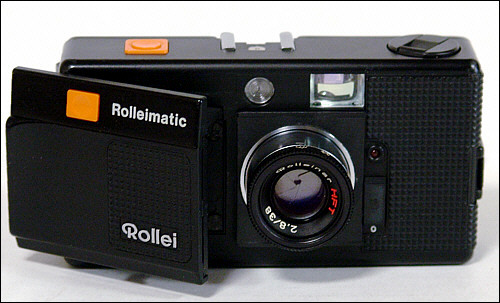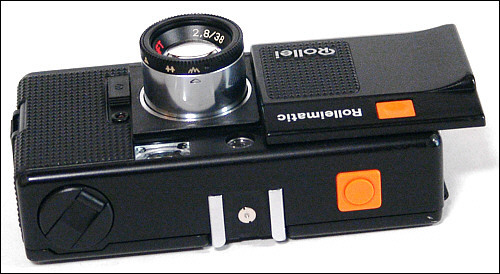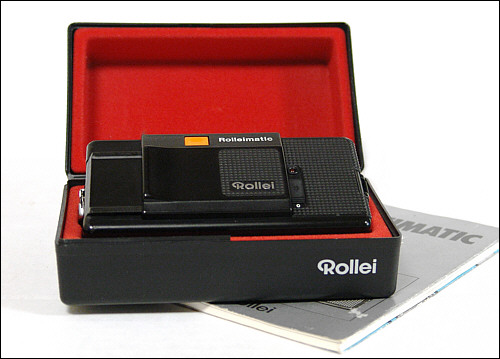Rollei Rolleimatic: From the Mind of Waaske*

One of the more unusual cameras to bear the Rollei name was the Rolleimatic. It's a camera that you don't see often. I wouldn't describe it as rare, but rather say that it's uncommon.
The Rolleimatic has a look and feel to it that sets it apart from most junk that typified the 1980s amateur point-and-shoot market. It's a handsome camera with rounded edges and decked out in black with white lettering, 1980s-style orange buttons and a polished chrome ring at the base of the lens. It reminds me a bit of a tuxedo with a little bit of extra verve!
If half of what you read on the Internet is true, then this camera has an unusual history to it.
The Rolleimatic was designed by Heinz Waaske, a camera designer who did a great deal of work for Wirgin. Waaske seemed to specialize in creating smaller cameras that also could be described as minimalist. They didn't have unnecessary features, dials or knobs to baffle the photographer when the "decisive" moment arrived.
How he came to work at Rollei is a great story. In paraphrasing everything that's been written, the story goes like this:
While at Wirgin, he worked in his spare time on his idea for what would become the Rollei 35. When he showed it to one of the co-owners of Wirgin -- who had helped to machine some of the parts -- the co-owner was unimpressed to the point of becoming enraged, yelling at him and eventually retiring and shutting down the Wirgin camera company.
It's the only time that I've heard that a prototype for a camera angered someone so much that it was a cause for a company to go out of business.
Waaske presented his idea to Leitz and later to Kodak, and was turned away by both. Waaske then joined Rollei and worked on various camera projects. He had been a bit gun shy because his idea for his miniature camera for the "miniature" format had now been rejected by three well-known camera makers. However, one day he shared his idea with the head of Rollei who immediately fell in love with it, and the rest is history with some two million Rollei 35 cameras sold over the next 20+ years.
I'm very impressed with the other Rollei projects in which Waaske was involved -- reportedly the Rolleiflex SL 26, the A110/E110, A26 and the Rolleimatic. The Rolleimatic also has the distinction of being Waaske's final camera for Rollei. It was released to the market after Waaske had left the camera maker. It didn't much matter, though, because it's his work through and through.
About that flap
The Rolleimatic's most distinctive feature is the front panel, which can be seen sitting at an angle in the photo at the top of this page. In addition to extending and collapsing the lens, the front panel also tensions the shutter and advances the film. As a result, the top deck is very clean with just a rewind crank, hot shoe and shutter release. I'll explain that other orange button -- the one that's on the front of the camera -- in a bit.
The lens is slightly wide angle at 38mm. This focal length was very popular for smaller cameras, starting in the mid-1970s. The instruction guide says that this Rolleinar is four elements in three groups, which I believe makes it a Tessar-type lens. Its maximum aperture is f/2.8, and the camera's ASA range is a bit limited (25 to 400), which puts it squarely into the amateur category.
The photos from this camera have a Tessar look to them. At wide apertures, when shooting close up, backgrounds have a roundness to them that is typical of a Tessar. At smaller apertures, things smooth out a bit, and photos are very sharp.
But why not a Sonnar? I don't know. Maybe it was a matter of cost. Regardless, a Tessar-type lens can be excellent. I should mention that the much-simpler A26 camera that took 126 Instamatic film had a Sonnar, while the SL 26 (an SLR) had a Tessar, although the reasons for that have to do with the SL 26 having accessory Pro-Tessar lenses.
 The camera uses pictograms as the primary means for focusing with the
distance scale engraved on the bottom of the lens barrel. That means that
you have to turn the camera upside down, if you would prefer to set the
distance by feet or meters rather than using the symbols. I would have liked the ability to rotate
the lens barrel so that the lens scale is on top, but alas that wasn't an option.
The camera uses pictograms as the primary means for focusing with the
distance scale engraved on the bottom of the lens barrel. That means that
you have to turn the camera upside down, if you would prefer to set the
distance by feet or meters rather than using the symbols. I would have liked the ability to rotate
the lens barrel so that the lens scale is on top, but alas that wasn't an option.
Again, I should point out that the A26 mentioned above uses the identical method for focusing. And the A26 also has a retracting lens. Internet postings say the Rolleimatic was originally designed to use 126 Instamatic film -- and its name certainly reflects that -- before being was changed to 35mm.
The back is locked in place by a clasp that snaps into place to prevent accidental opening of the back. It's different from other cameras that require the photographer to pull up on the rewind crank. It seems to be secure, although I wonder when the clasp will accidentally catch on a piece of clothing and ... oops.
The frame counter is on the bottom -- sort of like the Rollei 35. One nice touch is that the frame counter doesn't move if the film isn't loaded properly. This is a feature on several Rollei SL 35 models. The rewind button is actually a switch on the bottom of the camera, and it's complemented by a plastic rewind crank on the top deck. The bottom deck also holds the tripod socket and the threaded metal battery cover.

Film speeds are set by a slider on the back. And if you're shooting flash, you move the slider on the right to the correct aperture that should be indicated on the back of the flash unit. Doing so sets the shutter speed to 1/30. There is no provision for off-camera flash or bulb flash. Again, it's an amateur camera.
Oddly enough, the manual warns against setting intermediate film speeds even though there are click stops that allow the photographer to do just that. For example, for ASA64 film, it recommends rounding down to 50. For ASA160, it recommends setting it at 200. I'm baffled by this, because there are marks between 25-50-100-200-400 that would allow for setting those speeds, as you can see.
There is a small window on the left side of the back door to allow the photographer to see what kind of film is loaded. It's a nice touch for a camera from 1980 when this feature wasn't in wide use.
Like nearly all European cameras (including those made for Rollei in Singapore), it doesn't use light-blocking foam. That means that getting this camera into shooting shape was limited to a thorough cleaning of the body and careful cleaning of the optics plus a new battery to see that all systems were go. That was it.
About that flap, revisited
Loading the film is a bit fiddly, because you must insert the leader under one of the tiny flanges that surrounds the somewhat fat take-up spool. It took me a couple of tries to get it right. Close the back, and slide the front panel outward to reveal the lens. Now, push down on the end with the scallop and the lens extends. Depress the flap twice, fire the shutter and repeat until "1" appears and is centered in the frame counter window.
To advance the film to the next frame, depress the flap twice, remembering to push it flat against the body. After taking a photo, repeat the procedure. When you're ready to retract the lens for storage, depress the small orange button on the end of the flap while pressing the flap. It's easier than it sounds. Pushing the small square button moves a small arm under the flap, which engages the gearing to retract the lens. The mechanism under the multipurpose front panel seems a bit complex -- a bit too much for my taste. I wouldn't handle this camera too roughly.
The front of the body has a diamond pattern, as does the multipurpose panel, to give your fingers something to grip, and it's quite effective. The owner's manual mentions that you can use your body to brace the camera if you need to advance the film using just one hand. It specifically mentions if you are piloting a glider!

The construction of the Rolleimatic is a mix of metal and plastic. It's a substantial camera in terms of its weight. I wouldn't call it heavy, but it weighs more than you might expect. The build quality is very good.
The camera's programmed autoexposure is powered by a 6-volt PX28 cell or equivalent. And the meter uses a modern silicon cell, rather than CdS (cadmium sulfide), which had supplanted the batteryless selenium cell and by the 1980s was on its way out. The PX28 battery is easy to find today. Keep in mind that without a battery, you have no meter and, hence, no autoexposure, although you can improvise with a single manual speed of 1/30 and manually selected apertures of f/2.8 to f/16.
To conserve power, the camera's electronics and meter are activated only if the shutter has been tensioned, the lens extended and the panel is flush against the body. All three conditions must be met. That means, if you put the camera away with the shutter tensioned, the lens extended and panel flush against the body and something resting on the shutter release, you have only yourself to blame if the battery is then run down.
The viewfinder is spartan: There are the frame lines (no parallax indicators) and two LEDs to the left. One is green and the other is red. They help to indicate whether there is sufficient light and whether the battery has sufficient power. The range of the programmed exposure is very impressive: 1/500 at f/16 down to 4 seconds at f/2.8.
There is a 10-second electronic self-timer switch next to the lens. Slide the switch down, press the shutter release and the small red LED above the switch flashes until the shutter is released. Moving the switch to off during the countdown cycle causes the shutter to fire immediately. You can always switch off the self-timer before pressing the shutter release, should you change your mind.
The camera uses a Rollei 35-style connector for the wrist strap, so if you have a spare Rollei 35 wrist strap, it attaches easily to the Rolleimatic.
The boxed set included the plastic flock-lined case, the camera, a battery and the owner's manual. I'm not sure if there was a case or wrist strap included with the package, as they're listed as accessories in the owner's manual.
